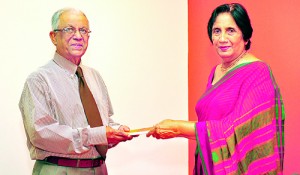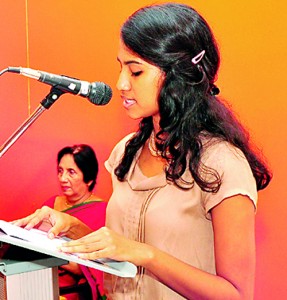Where a legend creates the present
View(s):Premini Amerasinghe’s latest book, The Golden Deer, is a contemporary novel that surprises readers by its use of the magical and the mythic in the most mundane and material setting. It is a story that appears seemingly impossible, a narrative of fabulous imaginings, unless the reader is aware of the contradictions of South Asian society that effortlessly interweave the mystic with the everyday.

Dr. Premini Amerasinghe presents her novel The Golden Deer to chief guest Dr. Reggie Seimon at the launch of her book at the ICES in Colombo on August 4. Pix by Mangala Weerasekera
Anushka and Rajiv, the two main characters of the story, are journalists from Mumbai who are drawn into the Ramayana legend during an assignment in Sri Lanka around the time of the second anniversary of the military victory over the LTTE. Anushka, a beautiful and cosmopolitan North Indian woman, finds that her life is inadvertently interwoven with the life of Sita, the wife of King Rama who was abducted by Ravana, the King of Lanka. Anushka experiences her first encounter with her past in Sri Lanka on her visit to Sigiriya, where legend claims that Ravana’s father, King Visvavasmuni, had built a fabulous palace long before King Kassappa transformed it into his fortress. In the serene gardens of Sigiriya, Rajiv hears Anushka’s unwitting regression to a past that she herself is not aware of, in a language that she cannot speak in her current life:
“[Rajiv] strode off, then stopped in his tracks, disturbed by a verse in Tamil intoned in a low voice. It was something about “a beauteous palace, walls lined with silver and gold ….” He missed part of it, but got the bit about “dancing girls, decked with jewels and pearls…” Surely a verse from Valmiki’s Ramayana? He glanced around, but there was no one else around apart from

Time to autograph books for well wishers and friends
Anushka! She was not at all fluent in Tamil. What was all this about? He wondered alarmed. Did Anushka’s sub-conscious hold the key to a pre-history enmeshed with myth and legend?”
Amerasinghe’s novel is the stuff of everyday reality of Sri Lankan and Indian society, where politicians turn to light readers to decide on the best day for an election, and sophisticated city dwellers spend hours in dimly-lit rooms searching for the ola leaves that are supposed to have an indelible record of their past and future births, and the destinies of all their loved ones. Anushka and Rajiv, however, do not even belong to this category of South Asians who dabble in what they would call, hocus pocus. Anushka is a convent educated, sophisticated political journalist, who, as a child, had been reprimanded by the nuns for her unwitting encounters with her past. A nun from her Kodikanal convent had had only this to say to Anushka for her excuse for going missing from the convent once:

eadings by grand-daughter Jemiah Sourjah
“Someone dressed like a king you said, took you in his arms, how you got there, you couldn’t tell us. Airborne! What nonsense. No one here had seen a stranger, neither the gardeners, nor the village people, and where was this great man when the police found you? He had gone to fetch you a crown, you said. Really Anushka, you read too many fairy tales!
Rajiv, too, when faced with the unavoidable fact of Anushka’s regressions into the past in Sri Lanka, turns to Anushka’s neurologist for guidance. The neurologist writes to Rajiv from India:
“As you know, I am a neurologist, with no real experience of the para-normal. My comments on possessed children are not based on practical experience, but derived from various scientific articles that I have read. I am confident however, that Anushka’s problem can be solved, and that her schizoid state will not be permanent. “
Yet, they find that the Ramayana legend has been woven inextricably through their lives, as they battle a local politician, a symbolic present-day Ravana, who abducts Anushka in his helicopter and takes her to his home which happens to be on the trail of the Sita-Ravana legend. Despite himself, Rajiv is forced to succumb to both the political whirlwind that he finds himself caught in, and to accept the possibility that Anushka’s healing and safety may lie at the point where the myth, literally, meets the present. Rajiv finally comes to terms with this possibility and ends up searching for Anushka on Sita’s trail:
“He had looked up the kidnapping of Sita on the internet. The likely jungle place was Hakgala, where Sita had been confined for twelve years. On the other hand, Anushka’s kidnapper was not aware of the interweaving of legend with life, unless a powerful force in operation directed him there, without his knowledge.”
Two themes are intertwined in the novel, the reversion of Anushka periodically to a previous incarnation, Sita, and the complications that arise after she was inadvertently a witness to a journalist’s murder and was able to identify the politician who was involved in it.
Amerasinghe’s novel ends with a symbolic twist when Sita comes into Anushka’s and Rajiv’s life in the form of Sita Devi. It is only when ‘Sita was Sita!’ that the past and the present are resolved forever.
(The book priced Rs. 500 is available at Sarasavi and Vijitha Yapa bookshops.)


